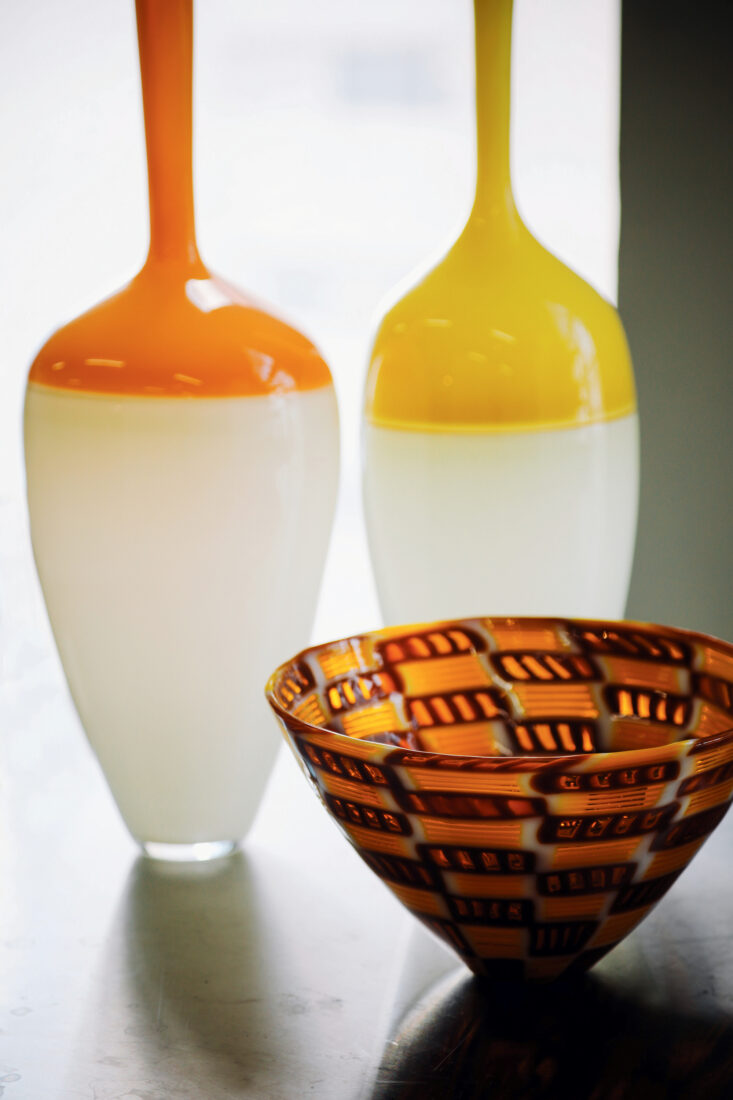One evening at Virginia Commonwealth University, Corey Pemberton saw a glow coming from a room. It was a glassblowing studio; the aspiring graphic design and illustration student hadn’t realized his campus had one. But watching molten glass turn into art that night made him want to seek his inner alchemist. The next day, he decided to major in craft and material studies instead. “From there, I took classes in ceramics, metals, textiles, and all sorts of glass techniques,” says Pemberton, who is now thirty-three and a sought-after artist. “I was playing with the idea of making work that wasn’t sequestered to, or limited by, a single medium.” His repertoire includes bold mixed-media paintings and ornate glassware, which have been exhibited at the likes of the Museum of Art and Design in New York City and the Boston Museum of Fine Art. He also serves on the boards of such institutions as the Corning Museum of Glass, and his paintings have caught the eye of celebrity collectors such as Alicia Keys and Lena Waithe.
Embracing his own voice, however, has been his real life’s work. As a mixed-race child growing up in Reston, Virginia, a largely white suburb, Pemberton says, he never felt white enough for the white kids. Art became his solace. Then a college professor introduced him to Sweetgrass Baskets and the Gullah Tradition, a history of the woven pieces that unlocked a “path to create forms inspired by the patterns I was seeing,” Pemberton says. You can spot that influence in his glassware, which he typically creates using the Italian murrine technique, embedding colored glass inside of clear glass and then stretching them to produce rods with patterns running throughout. He repeats the process until the design evokes the textiles and motifs that inspire him—Egyptian onyx-and-gold statues, say, or West African wedding lace. “It gave me permission to create Black work,” he says of that initial spark. “It became a way for me to investigate my culture.”

His blown-glass vases and a basket-weave murrine bowl.
After college, he honed his skills at North Carolina’s Penland School of Craft, where he later earned a fellowship. While there, he began painting, too. For those works, Pemberton takes photographs of his models—usually friends or family members—at their homes to see and include objects of importance to them. He then renders the backgrounds of the portraits like rich textiles, the environment just as meaningful as the person. “Black, brown, and queer people are often depicted in art in moments of trauma or being extraordinary,” he says. “A lot of people don’t realize what a privilege it is to be ordinary; to be depicted in a moment of rest. That’s the space I’m trying to fill with my art.”
In 2019, Pemberton and other Penland creatives cofounded Crafting the Future, a nonprofit that connects artists of color with educational and professional opportunities. He also hosts a residency program in Los Angeles, where he moved that year. But he still credits his drive, in part, to Southern hospitality. “That mentality built this love for people in me and a desire to lift other people up,” he says. “Whether it’s glassblowing, painting, or nonprofit work, it’s about people.”
Garden & Gun has an affiliate partnership with bookshop.org and may receive a portion of sales when a reader clicks to buy a book. All books are independently selected by the G&G editorial team.


